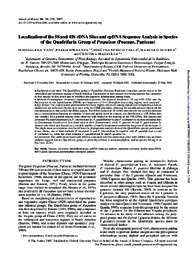Localizationof the 5S and 45S rDNA sites and CPDNA sequence analysis in species of the quadrifaria group of Paspalum (Poaceae, Panicae).
Localizationof the 5S and 45S rDNA sites and CPDNA sequence analysis in species of the quadrifaria group of Paspalum (Poaceae, Panicae).
Author(s): VAIO, M.; SPERANZA, P.; VALLS, J. F. M.; GUERRA, M.; MAZZELLA, C.
Summary: The Quadrifaria group of Paspalum (Poaceae, Paniceae) comprises species native to the subtropical and temperate regions of South America. The purpose of this research was to characterize the I genomes in five species of this group and to establish phylogenetic relationships among them. Prometaphase chromatin condensation patterns, the physical location of 5S and 45S rDNA sites by fluorescence in situ hybridization (FISH), and sequences of five chloroplast non-coding regions were analysed. The condensation patterns observed were highly conserved among diploid and tetraploid accessions studied and not influenced by the dyes used or by the FISH procedure, allowing the identification of almost all the chromosome pairs that carried the rDNA signals. The FISH analysis of 5S rDNA sites showed the same localization and a correspondence between the number of sites and ploidy level. In contrast, the distribution of 45S rDNA sites was variable. Two general patterns were observed with respect to the location of the 45S rDNA. The species and cytotypes Paspalum haumanii 2x, P. intermedium 2x, P. quadrifarium 4x and P. exaltatum 4x showed proximal sites on chromosome 8 and two to four distal sites in other chromosomes, while P. quarinii 4x and P. quadrifarium 2x showed only distal sites located on a variable number of small chromosomes and on the long arm of chromosome 1. The single most-parsimonious tree found from the phylogenetic analysis showed the Quadrifaria species partitioned in two clades, one of them includes P. haumanii 2x and P. intermedium 2x together with P. quadrifarium 4x and P. exaltatum 4x, while the other contains P. quadrifarium 2x and P. quarinii 4x. The subdivision found with FISH is consistent with the clades recovered with cpDNA data and both analyses suggest that the Quadrifaria group, as presently defined, is not monophyletic and its species belong in at least two clades.
Publication year: 2005
Types of publication: Journal article
Keywords: Gramineae, Paspalum, Quadrifaria, cpDNA, rRNA genes
Observation
Some of Embrapa's publications are published as ePub files. To read them, use or download one of the following free software options to your computer or mobile device. Android: Google Play Books; IOS: iBooks; Windows and Linux: Calibre.
Access other publications
Access the Agricultural Research Database (BDPA) to consult Embrapa's full library collection and records.
Visit Embrapa Bookstore to purchase books and other publications sold by Embrapa.

